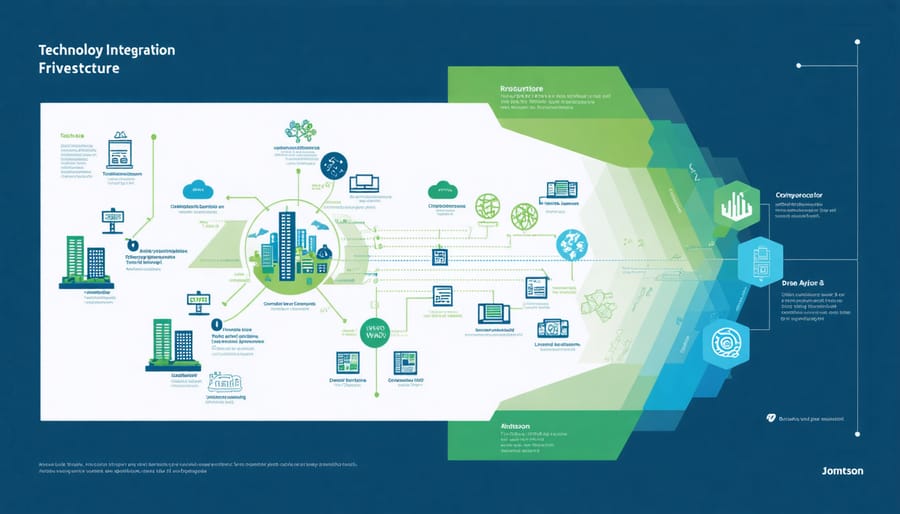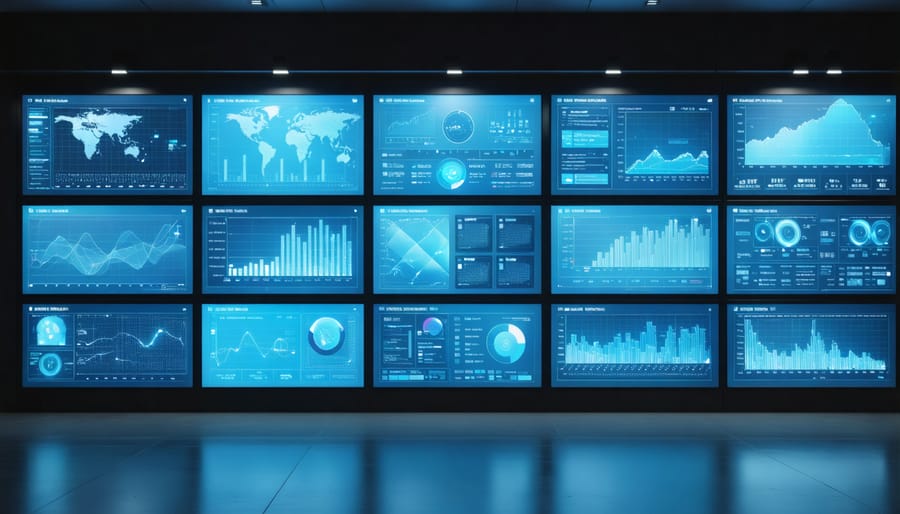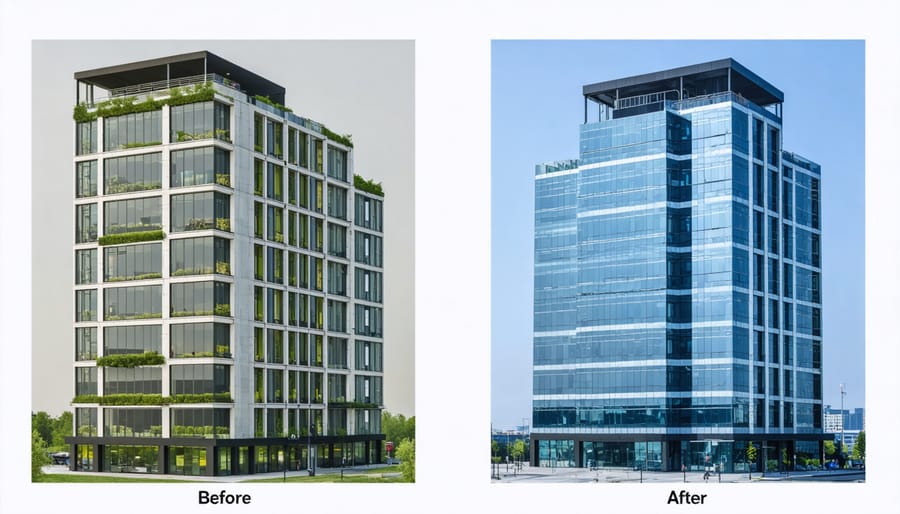In the race to combat climate change and optimize building performance, Johnson Controls stands at the forefront of revolutionizing sustainable building infrastructure. Their integrated solutions merge cutting-edge digital technology with time-tested engineering expertise to deliver measurable results: reducing energy consumption by up to 50%, decreasing operational costs by 30%, and achieving ambitious sustainability targets across diverse building portfolios.
The company’s OpenBlue digital platform represents a paradigm shift in building management, connecting critical systems through AI-driven analytics while enabling real-time optimization of energy usage, occupant comfort, and asset performance. This digital transformation of infrastructure management has positioned Johnson Controls as a crucial partner for organizations pursuing net-zero carbon goals and LEED certification.
For construction professionals and facility managers seeking to future-proof their buildings, Johnson Controls offers a comprehensive suite of solutions that seamlessly integrate with existing systems while providing clear pathways to sustainability benchmarks. Their track record of successful implementations across healthcare facilities, educational institutions, and commercial buildings demonstrates the scalability and reliability of their approach to sustainable infrastructure transformation.
Revolutionizing Building Infrastructure Through Strategic Partnerships
Key Partnership Initiatives
Johnson Controls has established strategic partnerships with industry leaders to accelerate the implementation of sustainable construction strategies worldwide. A landmark collaboration with Microsoft leverages Azure Digital Twins and AI technology to optimize building performance and reduce energy consumption across large-scale infrastructure projects. The partnership with Hitachi has resulted in innovative smart city solutions, combining IoT expertise with building automation systems.
The company’s alliance with the World Economic Forum’s Net Zero Carbon Cities initiative demonstrates its commitment to urban sustainability, providing technical expertise and resources to help cities achieve their climate goals. Through partnerships with leading universities, including MIT and Stanford, Johnson Controls continues to drive research and development in green building technologies and sustainable materials.
These collaborations have yielded measurable results, with partner projects achieving an average 30% reduction in energy consumption and 25% decrease in operational costs while significantly lowering carbon emissions. The company’s partnership ecosystem continues to expand, focusing on scalable solutions for smart, sustainable infrastructure development.
Technology Integration Framework
Johnson Controls employs a sophisticated multi-layered approach to technology integration, seamlessly combining building automation systems with sustainable infrastructure solutions. At the core of this framework is the OpenBlue digital platform, which leverages AI and IoT sensors to optimize building performance and energy efficiency in real-time.
The integration framework operates on three key levels: operational technology (OT), information technology (IT), and digital transformation solutions. Smart sensors and controllers form the foundation, collecting crucial data about energy consumption, occupancy patterns, and environmental conditions. This data feeds into advanced analytics systems that process information through machine learning algorithms to identify optimization opportunities and predict maintenance needs.
The framework incorporates cybersecurity protocols specifically designed for infrastructure applications, ensuring that sustainable systems remain protected while maintaining operational efficiency. Building managers can access comprehensive dashboards that provide actionable insights for energy management, while automated systems adjust building parameters based on real-time conditions and predefined sustainability goals.
By implementing edge computing solutions alongside cloud infrastructure, Johnson Controls ensures rapid response times and reliable system performance, even in challenging environments. This hybrid approach enables both immediate local control and comprehensive data analysis for long-term sustainability planning.

Innovation in Sustainable Building Solutions
Smart Building Management Systems
Johnson Controls leads the industry in delivering comprehensive smart building management solutions that optimize operational efficiency while promoting sustainability. Their integrated systems combine advanced automation, real-time monitoring, and artificial intelligence to create intelligent buildings that respond dynamically to occupant needs and environmental conditions.
At the core of their building management infrastructure is the Metasys® platform, which seamlessly integrates HVAC, lighting, security, and fire safety systems into a unified control environment. This integration enables facility managers to monitor and adjust building performance metrics through a single interface, significantly reducing energy consumption and operational costs.
The platform’s predictive maintenance capabilities utilize machine learning algorithms to identify potential equipment issues before they occur, minimizing downtime and extending asset lifecycles. Real-time analytics provide actionable insights for optimization, while automated responses to environmental changes ensure optimal comfort and energy efficiency.
Johnson Controls’ building management systems also incorporate IoT sensors and edge computing technology to collect and process data at the source, enabling faster response times and more efficient resource allocation. This smart infrastructure supports sustainable building certifications like LEED and WELL, while providing detailed reporting for environmental compliance and corporate sustainability initiatives.

Energy Efficiency Technologies
Johnson Controls leverages cutting-edge energy efficiency technologies to optimize building performance and reduce environmental impact. Their advanced Building Management Systems (BMS) integrate smart sensors, artificial intelligence, and machine learning algorithms to continuously monitor and adjust building operations in real-time.
A cornerstone of their energy efficiency solutions is the OpenBlue platform, which uses cloud computing and IoT connectivity to create intelligent building ecosystems. This system enables predictive maintenance, optimizes HVAC operations, and manages lighting systems to achieve maximum energy savings while maintaining occupant comfort.
The company’s Variable Refrigerant Flow (VRF) systems demonstrate significant energy savings by precisely controlling refrigerant flow based on actual demand. These systems have shown energy reduction of up to 40% compared to conventional HVAC systems in commercial buildings.
Smart lighting controls incorporate daylight harvesting and occupancy sensing, automatically adjusting artificial lighting levels based on natural light availability and space utilization. Advanced metering and monitoring systems provide granular energy consumption data, enabling facility managers to identify inefficiencies and implement targeted improvements.
Johnson Controls also implements thermal energy storage solutions, allowing buildings to shift cooling loads to off-peak hours, reducing both energy costs and grid demand. Their battery storage systems integrate with renewable energy sources, optimizing energy usage and providing backup power capabilities while supporting grid stability.
Case Study: Sustainable Infrastructure Success Stories
Commercial Building Transformations
Johnson Controls has revolutionized commercial building sustainability through strategic retrofits and upgrades across diverse property portfolios. Notable transformations include the implementation of smart HVAC systems that reduce energy consumption by up to 40% while maintaining optimal occupant comfort. These systems leverage advanced sensors and AI-driven controls to automatically adjust building operations based on real-time occupancy and environmental conditions.
In major office complexes, the integration of IoT-enabled lighting systems has decreased electricity usage by 35%, while smart window technologies have significantly reduced solar heat gain and cooling demands. Building managers report enhanced tenant satisfaction and substantial operational cost savings following these implementations.
Data centers have benefited from innovative cooling solutions that combine free cooling technology with intelligent thermal management, resulting in a 50% reduction in cooling-related energy consumption. Retail spaces have seen transformative results through the installation of integrated building management systems that optimize energy usage across multiple locations while providing centralized control and monitoring capabilities.
These upgrades typically achieve ROI within 3-5 years while substantially improving building performance metrics. Success stories include numerous LEED certification achievements and Energy Star ratings, demonstrating the tangible impact of Johnson Controls’ sustainable infrastructure solutions in the commercial sector.

Industrial Facility Innovations
Johnson Controls has successfully implemented numerous groundbreaking sustainability initiatives across various industrial facilities worldwide. One notable case study is the transformation of a 500,000-square-foot manufacturing facility in Milwaukee, where smart building technologies reduced energy consumption by 42% within the first year. The facility incorporated advanced IoT sensors, AI-driven climate control systems, and renewable energy integration.
Another exemplary implementation occurred at a pharmaceutical manufacturing plant in Singapore, where Johnson Controls deployed their OpenBlue platform to optimize operations. The solution achieved a 35% reduction in water usage and a 28% decrease in carbon emissions through intelligent resource management and predictive maintenance protocols.
In Germany, a large automotive manufacturing facility showcases the company’s comprehensive approach to industrial sustainability. The installation of high-efficiency HVAC systems, combined with advanced energy storage solutions and smart lighting controls, resulted in annual energy savings of €2.3 million while maintaining optimal production conditions.
These implementations demonstrate Johnson Controls’ ability to deliver measurable sustainability improvements while enhancing operational efficiency. Each project utilizes data-driven decisions and integrated systems to achieve environmental targets without compromising industrial output. The success of these initiatives has established new benchmarks for sustainable industrial operations across multiple sectors.
Future-Proofing Construction Through Sustainable Partnerships
Johnson Controls’ commitment to future-proofing construction through sustainable partnerships represents a paradigm shift in infrastructure development. The company’s forward-looking approach integrates emerging technologies with established sustainability practices, creating a blueprint for industry-wide transformation.
Recent partnerships with leading technology providers have yielded innovative solutions in building automation, energy management, and carbon reduction. These collaborations focus on developing AI-driven systems that optimize resource utilization while maintaining operational efficiency. Industry analysts project that such smart building solutions will reduce energy consumption by up to 30% in the next decade.
Johnson Controls’ partnership ecosystem extends beyond technology providers to include research institutions and governmental bodies. These alliances are crucial in developing standards and best practices for sustainable infrastructure that align with evolving environmental regulations and climate goals.
The company’s investment in digital twin technology, coupled with strategic partnerships in the IoT sector, enables predictive maintenance and real-time optimization of building systems. This approach not only enhances operational efficiency but also extends the lifecycle of infrastructure assets while reducing environmental impact.
Looking ahead, Johnson Controls is pioneering initiatives in renewable energy integration and circular economy principles. Their partnership strategy emphasizes scalable solutions that can be implemented across diverse building portfolios, ensuring long-term sustainability and adaptability to changing environmental conditions.
These collaborative efforts are setting new benchmarks for sustainable infrastructure, demonstrating how strategic partnerships can drive innovation while meeting increasingly stringent environmental standards and market demands.
Johnson Controls’ commitment to sustainable infrastructure has demonstrated significant impact across the construction and building management sectors. Through strategic partnerships and innovative solutions, the company has helped organizations worldwide reduce their carbon footprint while optimizing operational efficiency. The implementation of their smart building technologies and energy management systems has resulted in measurable improvements, with partner facilities reporting average energy savings of 20-30% and substantial reductions in maintenance costs.
Looking ahead, Johnson Controls continues to expand its sustainable infrastructure initiatives, with particular focus on developing AI-driven building management solutions and enhancing their OpenBlue digital platform. The company’s roadmap includes strengthening collaborations with technology providers, construction firms, and government entities to accelerate the adoption of sustainable building practices.
The future outlook appears promising as market demand for sustainable infrastructure solutions grows. With increasing pressure on organizations to meet environmental targets and optimize resource utilization, Johnson Controls is well-positioned to lead the industry’s transformation toward more sustainable practices. Their continued investment in research and development, combined with their extensive partner network, suggests a trajectory of continued innovation and market leadership in sustainable infrastructure solutions.

